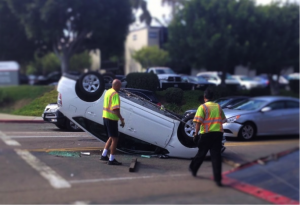An In-depth Look At Successful vs. Failed Wrongful Death Lawsuit Case Examples
One of the best ways to understand the complex characteristics of a wrongful death lawsuit is to examine real-life case examples. This blog takes an in-depth look at both successful and failed wrongful death lawsuits, and the wrongful actions that were the basis for them.

Understanding an Oregon Wrongful Death Lawsuit
An Oregon wrongful death lawsuit can be brought against an individual(s), corporation, or government entity, when the death of one individual is caused by the “wrongful actions or omissions of another[1].” For example, if a person climbs a ladder and then subsequently falls to their death – could this result in a wrongful death lawsuit? You don’t know until you examine the cause of the fall. If the fall was caused by a design or manufacturing defect in the ladder, or if another individual carelessly struck the ladder causing the fall, then there might be a claim for wrongful death. On the other hand, if the person on the ladder accidentally slipped and fell because of their actions, then reasonable people would call this an accident and not wrongful death.
Oregon state law regarding a wrongful death lawsuit has evolved several times since its original enactment in 1862. Prior to the enactment of Oregon wrongful death statutes, there was no Oregon common law allowing financial compensation to the estate of a deceased person for a wrongfully caused death – in other words, when a person died as a result of the actions or inactions of others, the right for the estate to seek compensation for the wrongful death also ended. Over the years, the Oregon legislature has amended the law several times. Today, Oregon’s wrongful death statute, ORS 30.020, defines what is a wrongful death, who can seek compensation, the type of damages (or compensation) that can be sought, and the limitations associated with a wrongful death claim, such as the applicable timeframe in which a lawsuit may be brought.
A Wrongful Death Lawsuit Can be Difficult to Understand and Prove

The key to winning a wrongful death lawsuit is proving, “by a preponderance of the evidence,” that the deceased person was owed a “Duty of Care” by the wrongdoer, who subsequently failed to provide that care, and the wrongdoer’s actions directly caused the deceased person’s wrongful death.
- Duty of Care –To prove a duty of care, the Plaintiff’s legal team must identify the responsible party or parties (the Defendant), and identify what duty of care they owed the deceased. Duty of care is defined as a legal obligation imposed on an individual or company, whose actions could foreseeably harm others. That person has a duty of care to act with caution, attention, and prudence that a reasonable person in the same circumstances would use[1]. For instance, there are many Oregon laws that create a duty of care for drivers, doctors, manufacturers of consumer goods, healthcare providers, and construction companies. When persons or companies fail to adhere to these laws their actions can result in the injury or death of innocent people.
- Breach of Duty of Care – the Plaintiff must also prove that the Defendant breached or failed to provide the duty of care owed to the Defendant. For example, car manufacturers have a legal obligation to provide certain safety devices and meet safety performance standards to sell cars to the public. If they fail to provide functioning airbags they can be held liable for wrongful deaths caused by the failed airbags.
- Causation – the Plaintiff must also show that the Defendant’s conduct or failure to act caused the wrongful death of the deceased person. It is not enough to prove the Defendants owed a duty of care and subsequently through their actions failed to provide the care. You must also prove the defendant’s actions caused the wrongful death. For example, if you are picking up the neighbor kids from soccer practice, you owe them a duty of care to obey Oregon traffic laws and not run a red light. If you do run a red light and cause an accident in which one of the kids dies, then you have directly caused the wrongful death.
Examples of Wrongful Death Lawsuits
One of the best ways to understand the characteristics of a wrongful death lawsuit is to examine real-world case examples. Here are some examples of wrongful death lawsuits and the wrongful actions that were the basis for them:
- Driving under the influence, distracted driving, violating motor vehicle laws (speeding, failure to signal, etc.), or failing to yield to pedestrians.
A 26-year old Portland man was riding in the backseat of a friend’s car when he was killed instantly in a T-bone crash, the result of his friend running a stop sign. The mother of the decedent brought a wrongful death lawsuit against the driver of the car alleging the driver’s negligent driving directly caused her son’s death. The mother’s lawsuit was successful but took several unusual twists. The at-fault driver had no insurance and little assets. Because the decedent did not drive (he used a bicycle and public transportation), he had no auto insurance, which would have included a modest amount of Uninsured Motorist Insurance (UIM) coverage. However, because he was living with his mother, Oregon law recognizes insurance coverage under his mother’s auto insurance policy for every blood relative. Bottom-line: the decedent’s estate collected the full UIM insurance policy limit from his mother’s car insurance policy for damages including funeral expenses, lost income to the estate and the loss of companionship to the decedent’s parents.

- Failure to provide adequate medical or nursing home care.
A Bend, Oregon woman went to St. Charles hospital after suffering a seizure. Doctors correctly diagnosed the seizure and prescribed anti-seizure medication. Instead of administering the prescribed medication, hospital staff incorrectly administered a fatal dose of a paralyzing drug, ultimately causing her death. Every hospital has a legal obligation (duty of care) to implement procedures that will prevent incorrect drugs and doses from being administered to the wrong patients. After an extensive investigation of the cause of death and the hospital’s operating procedures, the hospital was found at fault for directly causing her death, because of flawed procedures, and drug handling/labeling requirements. In this case, the woman’s death was directly linked to the hospital’s actions (administering the wrong drugs) and failure to act (not providing adequate procedures to ensure the correct medications were filled).
- Defective or dangerous products.
In December 2016, IKEA settled several wrongful death lawsuits for $50 million, over the deaths of three toddlers that were crushed when IKEA dressers fell on top of them. The Swedish company failed to meet ASTM Standard F2057-14 associated with protecting against unstable dressers and chests. IKEA voluntarily recalled the furniture in question in June 2016, in one of the largest furniture recalls in history, but not until many years after they became aware of tip-over wrongful deaths in 1989. The wrongful death lawsuits brought by the parents alleged that the products were defective and did not meet ASTM safety standards and that IKEA continued to sell the unstable products after becoming aware of the tip-over risk. It wasn’t until IKEA initiated the recall that they provided tip-over restraints and a full wall anchoring kit with hardware, instructions, and warning labels. The wrongful death lawsuits sought damages for medical expenses, pain and suffering, emotional distress, and funeral expenses, as well as punitive damages.
- Assault, excessive use of force, illegal or inappropriate police actions.
A Deschutes County man, arrested for intoxication in 2014, subsequently died in the county jail of a methamphetamine overdose, while jail staff watched and were slow to call for medical assistance. After investigating the actions of the jail deputies, Deschutes County District Attorney stated, “A sober assessment of the facts indicates … mistakes were made and professionalism was lacking.” While all jail officers were cleared of criminal acts, the family of the deceased filed a civil wrongful death lawsuit. The lawsuit alleges that jail staff did not properly supervise or provide adequate medical care and that these actions directly led to his death. While the investigation was unable to criminally establish “beyond a reasonable doubt” that the actions of the deputies caused the death, a $1M settlement in the civil wrongful death lawsuit was reached by the parties. In civil cases, the burden of proof is based on “a preponderance of the evidence,” which can also be understood as “what is more likely true than not true” or “just over 50%”. In this case, video of the jail deputy actions and comments would have been very damaging – most likely supporting the fact that jail staff did not properly supervise or provide adequate medical care.
- Failure to maintain a safe working environment or provide adequate safety equipment and training – chemical exposure, violating OSHA regulations, not adhering to established safety procedures, etc.
In 2015, a wrongful death lawsuit was filed in Multnomah County for the wrongful death of a worker who was poisoned by carbon monoxide when, while on a work site, his employer forced him to defecate in a bucket in the back of an enclosed work truck next to a gas-powered washer. The decedent’s employer was fined by OSHA for safety violations, which included exposure to fumes from a gas-powered pressure washer, and failing to provide proper toilet facilities. The wrongful death lawsuit, which is still pending, asserts claims for defective product against the manufacturer and seller of the gas-powered pressure washer, and claims for battery and violations of the employer liability law against the decedent’s employer and its affiliated companies.
Unsuccessful Wrongful Death Lawsuit Examples
It is frequently very difficult to prove that someone’s actions, or failure to act, directly caused the death of another person. This is illustrated in the following wrongful death lawsuit examples:
Judge ruled … alleged design defects did not “cause” the crash.
Two individuals, driving aggressively in a Porsche Carrera GT, lost control of their vehicle and crashed, killing both the driver and passenger. The families of the deceased brought separate wrongful death lawsuits against the vehicle manufacturer, Porsche, claiming various design and manufacturing defects caused the death of their loved ones. While Porsche could easily argue that out-of-control, aggressive driving was the cause of their deaths, the families believed that improvements in the design of the car should have been made to mitigate the effects of the crash – such as stronger side-impact reinforcements and a break-away fuel line. In one of the lawsuits, the judge ruled in favor of Porsche essentially concluding that the alleged design defects did not “cause” the crash. Proving “by a preponderance of the evidence,” that one party’s actions, or failure to act, caused the deceased person’s death, is an essential part of every wrongful death lawsuit. If the evidence had shown that a design defect or manufacturing failure caused the car to go out-of-control, then the legal outcome might have been completely different. Instead, the evidence showed that while various design improvements might have diminished the severity of the injuries, the lack of these improvements did not cause the crash and hence their deaths.
Unable to convince the court the coach’s actions “caused” the death of their son.
In October 2014, a 13-year-old Woodburn School District student was hit by a train and died. The student had left soccer practice unaccompanied and was headed home when the fatal incident occurred. A wrongful death lawsuit was filed by the student’s parents alleging, according to a Woodburn Independent article[2], the soccer coach’s actions were a “substantial factor” in the student’s death. This past October 2016, the case was dismissed with “prejudice”, meaning the court has dismissed the lawsuit and forbid the family from filing another lawsuit based on the same legal grounds. Although the family felt the soccer coach’s actions may have contributed to the accident, they were unable to convince a court that the coach’s actions caused the death of their son, and hence the school district was not liable for any damages.
Wrongful Death Lawsuit Attorney

If a loved one has been killed because of another person’s conduct, and you are looking for a skilled wrongful death attorney to lead you through the insurance roadblocks, the legal system, and wrongful death lawsuits, then please call today for a free and confidential case evaluation. Local (503) 610-0005 Toll-free 1 (800) 949-1481 or email travis@mayorlaw.com.
For additional information about wrongful death lawsuits and personal injury cases, I recommend the following articles on my Blog:
- Attorney Answers: Top 8 questions regarding a wrongful death lawsuit
- Oregon Wrongful Death Claims
- Portland Wrongful Death Attorney
- Oregon Attorney Travis Mayor of Mayor Law, LLC Obtains Settlement From City of Seaside for Wrongful Death Lawsuit
- Mayor Law Case Results
[1] Source: http://dictionary.law.com/Default.aspx?selected=599.
[2] Source: http://portlandtribune.com/wbi/152-news/326873-206651-wrongful-death-lawsuit-dismissed.
[3] Source: https://www.oregonlaws.org/ors/30.020.
